November 7, 1998-Touring Fiji
 Ovalau
OvalauWe knew there was a path through these reefs, the chart clearly showed one, but it also showed several navigation markers. Where were those?
Finally I spotted some broken posts, one with a drooping metal sign. Ahah! These must be the markers. We proceeded carefully through the narrow, twisting passage, past missing markers, with reefs on both sides. It took the two of us, both fully attentive, to keep Wings safe, and it took three days!
Navigating in Fiji around Viti Levu’s North Coast to rejoin Elyxir at Ovalau had seemed like a good idea, surely an unusual one in the minds of our friends back at Malolo Lailai, but motoring inside the reefs instead of sailing farther north in Bligh waters, made it one of our more stressful trips. We were lucky to make it without mishap.
The pay off was being able to visit some out of the way places, well off the tourist path.
We anchored each afternoon and stayed overnight tucked behind points of land and in small bays, and we went ashore to explore the empty shorelines. Walking down lonely roads surrounded by sugar cane fields we saw only a cow here and there and an occasional house among the rolling hills. From time to time we could hear a car or bus roar by on the highway, on their way around the big island, but we saw few people.
Road to Rakiraki
This part of Fiji is a very quiet place.
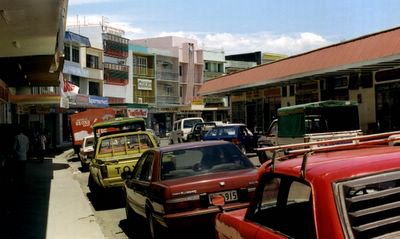 Ba
BaOne day we made it to the highway and hitched a ride into Ba, one of the sugar towns on this coast. Here we found a few Indian department stores and curry restaurants, and all the women were dressed in sari’s.
Boats
We had it in mind to go to Rakiraki, simply because the exotic name attracted us, but the day wore on and we headed back to Vitia Wharf, behind which Wings was anchored. When we got there we found the tide had gone out and left our dingy stranded by 100 yards of thick mud and sharp barnacled rocks.
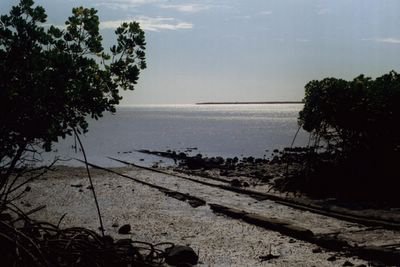
Getting through that mess to the water was a struggle.
Another day we anchored in Ellington Bay and met a couple of Indian men who had turned from sugar farming to fishing. They stopped their 14’ plywood craft alongside and came aboard for a tour. They expressed wonderment at the winches and other equipment on Wings. At Ellington Bay there was a large passenger ferry, the “Ovalau”, tied to a pier, and appearing disused. We could hear a gen. set running, and saw laundry hanging out on the upper deck. There must be some residents.
The biggest town was Lautoka, a bustling city with an economy based on sugar mills. We found our way to the central market and smelled the rich aromas of bulk spices, and we had lunches in the curry houses. We found supermarkets for provisioning, and great prices at shops of all kinds. When we got back to the boat we found black snowflake sized ashes from the mills covering our decks, and it was a continuing struggle to clean off the sooty stains.
We enjoyed this part of the coast, more than the Yasawas, the popular island group in Nadi Waters where most of the cruisers headed after race week. There we’d found traveling dangerous in the vast uncharted areas and, with the exception of the “Blue Lagoon”, poor harbors. The contrast between the peoples who lived there and those on the North Coast was also educational. In the Yasawa’s there were Fijian villages, with grass houses and a communal live style little changed for centuries. Children ran naked in the village and the adults frequently demanded fees from yachts. On the North Coast the Indian people had frame or brick houses, and their kids were sent off to school every day dressed in neat clothes and shined shoes, packing bundles of school books. We saw these two divergent cultures first hand and could see for ourselves why clashes were going to be inevitable as the industrious Indians gradually accumulated wealth and the Fijians stagnated.
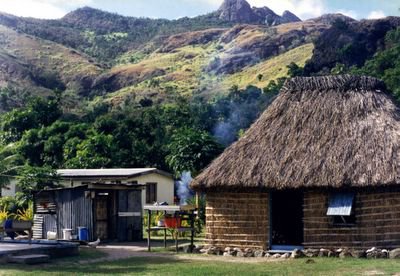 Waya Island
Waya IslandRounding the NE corner of Viti Levu we finally reached open waters and could again set sail. Elixir awaited us at Naigani Island. This was again land occupied by Fijians, and after we anchored we made our way to the chief’s house to perform Sevu Sevu with the village elders, a ceremony in which we made an offer of Yagona, the bundled roots of the Kava plant, and they in turn shared a bowl of Kava, the narcotic drink prepared from those roots. The ceremony completed, we received permission to stay the night. Afterwards one elder took us aside and told us that the poor quality of our Yagona was an insult to the chief, and we were lucky not to be snubbed because of it. The requirement to do the Sevu Sevu at every island aggravated us.
Going to do Sevu Sevu
During colonial times the capital of Fiji was the town of Levuka, on Ovalau Island, and we anchored there off the main street, and then went ashore and walked along the older wooden buildings. For a price, a taxi driver took us on a tour of the island, where we saw a white church standing stark against the green jungles.
Ovalau Boats
There was more to our tour of Fiji, including visits to Vuda Point, Port Denerau, and Nadi, all in the West, and a stay in the Gnau Islands, in the East, where the Fijians turned Sevu Sevu into a full on press for cash donations. We completed our circumnavigation of Viti Levu when we arrived in Suva, the capital.
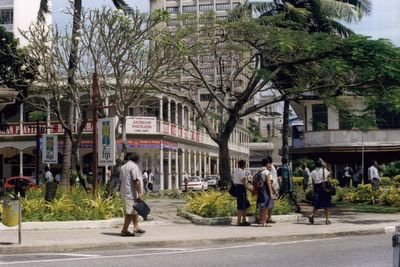 Suva
SuvaRoyal Suva Yacht Club
In Suva we stayed at the Royal Suva Yacht Club, shopped in town, went to western movies, and enjoyed cool drinks at the yacht club bar. We also participated in a race in with the local boats, a hair raising affair among reefs and other obstacles, and were happy to get through unscathed.
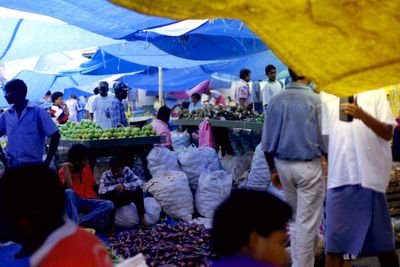 Suva Market
Suva MarketAs much as we’d seen of Fiji in nearly three months, we’d hardly scratched the surface, but it was time to prepare for the passage to New Zealand. As we got ready to depart, we made a promise to return.
Judy
Fred & Judy, SV Wings, Fiji
Labels: Fiji

.jpg)

0 Comments:
Post a Comment
<< Home